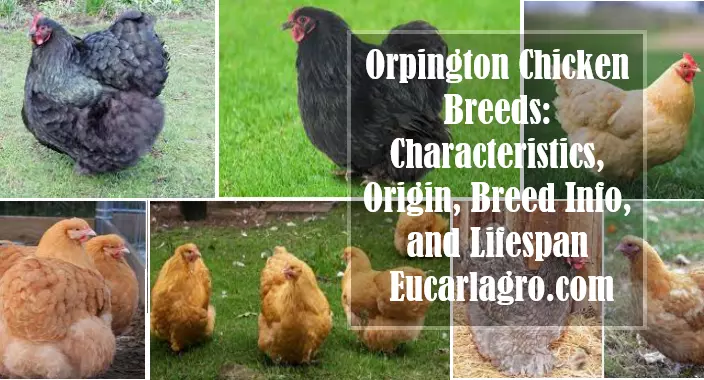Brahma Chicken Breeds: Characteristics, Origin, Breed Info, and Lifespan
Brahma chicken breeds are calm, friendly, and docile birds that can be kept as pets. They are well known for their large size and quiet nature. This bird is a good choice if you want loving pets that will make a great addition to your family.
The Brahma chickens are often tagged “gentle giants” because they are both huge and calm. They are named after the great Hindu God of Creation, and these gentle giants embody the spirit of Brahma in their way by being calm and sweet.
These great egg layers might become your new best friend if you properly care for them. Brahmas can get to be quite vicious if you neglect them or treat them lesser than you do with the young ones.
In this article, we have detailed all you need to know about the Brahma chicken breeds – their origin, characteristics, egg-laying capacity, lifespan, and the environment where they thrive best in.
You would get to know the different varieties of Brahma chickens, how to manage them, and whether you should commercialize or keep the Brahma chickens for your backyard poultry.
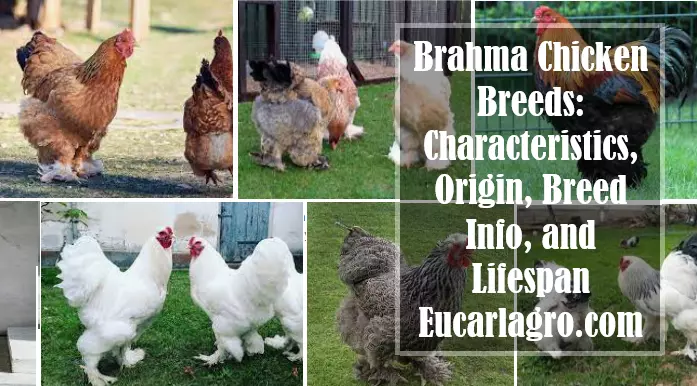
What is a Brahma Chicken?
The Brahma is an American chicken breed. It was developed as a hybrid chicken in the United States using birds imported from Shanghai – Chinese. They used to be the major American meat breed between 1850 and 1930.
Brahma chicken breeds are large birds popularly described as the “King of All Poultry.” They have massive body weight with full fluffy feathers. Brahma chickens possess great strength and vigor to forage for their food themselves even if you fill their feeding troughs to the brim.
The Brahma chicken is a dual-purpose bird with abundant meat and egg production; best for both commercial farmers and backyard farmers.
They are also beautiful birds that you can have around as a pet in your home. They are suitable for first-time chicken buyers because of their calm spirit.
Origin of the Brahma Chicken Breeds
There have been a lot of controversies as to the Origin of the Brahma Chicken Breeds. Some claim that the birds were developed in the United States by a Vermonter named Robert J.Brahma, from Chinese birds imported into the country. These were the Shanghai birds that had feathered legs similar to that of the Brahmas.
Also, the large head shape and pea comb of the Brahma resembled that of the Malay type Grey Chittagong birds, imported from Chittagong in Eastern Bengal (now Bangladesh).
These distinctive traits signal that the Brahmas resulted from cross-breeding of Shanghai and Grey Chittagong Chicken Breeds.
During the time the Brahma chicken breeds were first developed, they were given lots of names such as Brahma Portra, Burnham, Gray Chittagong, and Shanghai; because of their different strains. It was at a meeting of poultry judges in Boston in 1852, that the name “Brahmapootra” was agreed upon; this later became “Brahma”. This name came into play because the Brahmas were an Asiatic poultry breed, thus they were named after the Brahmaputra River in India.
In December 1852, George P.T Burnham sent nine “Gray Shanghaes” as a gift to Queen Victoria, then the Brahmas were first exported to England. Chicken breeders in England developed the Dark Brahma variety from this stock, Barnum exhibited them in his “Brahma Bull” show and re-exported them to the United States.
The light and dark (penciled) Brahma were added to the first British Poultry Standard in 1865, published by the original Poultry Club of Great Britain; and the first Standard of Perfection of the American Poultry Association in 1874
Characteristics of Brahma Chickens
1. The Body Skeleton of Brahma Chicken Breeds
Brahma chickens are very tall. Though the males are taller than the hen, the height of this chicken breed is yet outstanding. They are taller than some children and can reach up to 30 inches.
2. Feathers of the Brahma Chicken
They have full feathers patterned in a similar way to that of the Orpington chickens. Just like the Orpingtons, their feathers extend to their legs but here, theirs continue to reach their outer toes. The plumage of Brahmas is fluffy too.
3. Comb Type and Wattle Color of Brahma Chickens
The Brahma chicken breed has a large head when compared to other chickens. They appear to be mean because of the way their wattle hang down their head. The comb of Brahmas is pea-shaped and even as they are calm birds, their beak is short and powerful.
4. The Skin of the Brahma Chicken
Brahma chicken breeds have smooth fleshy white skin.
5. Egg Colour of Brahma Chicken Breeds
Not only do they pack up weight, but they are also good egg-laying birds. Their large size compensates for their increased egg production. They go broody in early summer but in the winter season, that is, between October and May, they are at their best with egg production.
The egg of Brahmas is medium to large in size and brown in color. The hen should stay far from its chicks after hatching. This is to prevent them from trampling on the chicks with their large body weight. After some days, you can then let the chicks go back to their mother.
6. Weight of the Chickens
Brahma Chicken Breeds are very heavy birds. The weight of the ancestral males of this breed is 18 lbs while the hens weigh 13 lbs. This is the average size of heritage turkey breeds. However, in recent times, the new varieties of chicken weigh much lesser than their ancestors.
Newer male varieties weigh 12 lb (5.5 kg) and the hens – 9.9 lb (4.5 kg).
7. Habitat and Environment of Brahma Chicken Breed
Brahma chickens are best bred on well-drained soils in cool climates. Brahmas are hardy chickens and can survive extreme weather conditions, especially cold winter seasons. Their large plumage enables them to adapt to the cool weather conditions.
Since the northern regions are moist and cold, the Brahmas would thrive best there. They would continue laying eggs throughout the winter season.
8. Growth Rate of Brahma Chickens
Brahma chickens grow slowly though they are excellent foragers and heavy feeders. They take a long time to mature which can be up to 2 – 3 years before they can reach their large size.
By feeding them regularly, the Brahma chicken breeds are sure to attain their giant nature. As foragers, they can easily feed themselves with the bugs and worms in the garden but for optimal growth, you need to supplement their diets.
Since feeding is a very important aspect of the lives of Brahma Chickens, What do Brahma chickens eat to grow big?
For the egg-laying Brahma hens, their feeds should be rich in greens, calcium, and protein. These nutrients help to improve their egg-laying routine both in number and size.
Not that if you boost the feeders of your Brahma chickens, they would become the biggest in the world. They would become huge but on average they do not reach the size of the Jersey Giant- the biggest chicken breed in the world.
The Lifespan Of Brahma Chickens
Brahma chickens have a similar lifespan to the Araucanas and speckled Sussex Chicken Breeds of 5-8 years. The Brahmas may pack up before this period if they do not receive proper veterinary care, a warm to cool poultry house, and at least a 16% protein chicken feed.
Varieties of the Brahma Chickens
There are three color varieties of the Brahma chicken breeds recognized by the American Standard of Perfection. These include light, dark, and buff.
Light Brahma
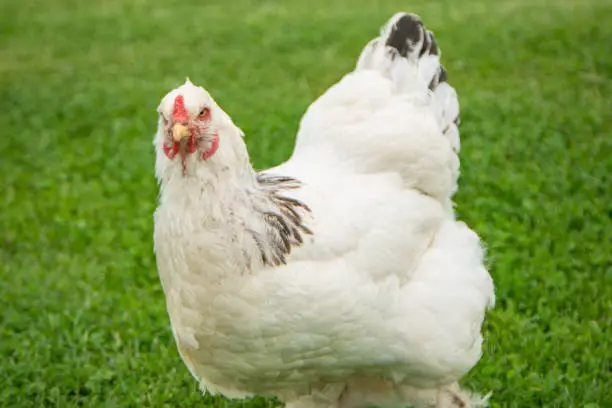
The light Brahma has a white base color, black hackles with white edges, and a black tail. The light Brahma males have black striped saddle feathers.
Buff Brahma
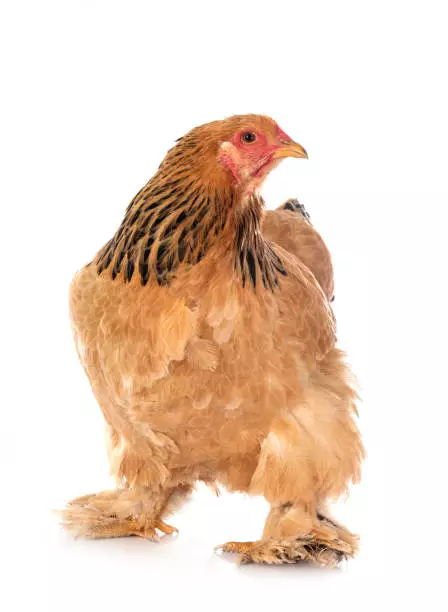
The Buff Brahma has a similar pattern to the black, but instead of the white, it had a golden buff base color.
Dark Brahma Chicken
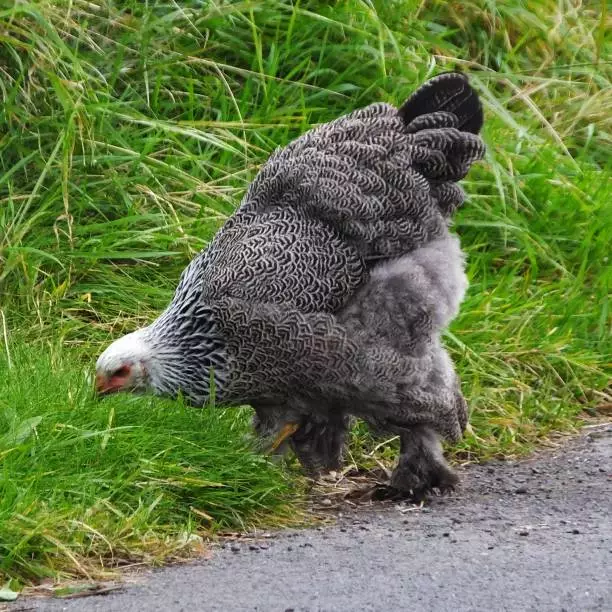
You can spot the difference between a dark Brahma male from a dark Brahma hen just from their feathers. The feathers of the Brahma hen are dark grey and black with white stripes. The male Brahma also has black feathers but instead with white stripes, saddle feathers, black underside, and tail. The primary feathers have white tips and their wings are White-shouldered.
The Australian Poultry Association added new varieties to the Brahma chicken breeds including the barred, black, blue, creme, and partridge varieties.
Breed Information of the Brahma Chickens
Unique Traits of the Brahma Chicken Breeds
1. Brahma Chickens Can’t Fly
The wings of Brahma chickens are powerful, but they can’t fly because of their large body weight. The wings are not suited to carry their body weight so they are restrained to walk around the farm.
2. Brahmas are Quiet Birds
The noise level of Brahma chickens is relative. When compared to other chicken breeds, they do not make a lot of noise. Their highest noise may be prompted by a predator or they’re trying to lay an egg.
This trait suits them for urban areas because you won’t be hearing much chicken noise from your backyard. You would also want to ensure that they have enough roaming space so they don’t feel stuffed.
Specs of the Brahma Chicken Breeds
1. They Are The Best Birds For Poultry Shows
You would love to choose the Brahma chickens for your farm if you use them for ornamental purposes
2. Brahma Chickens Are Great Meat Birds
This breed of chicken is very fleshy and as such good for commercial meat production.
The Brahma Chicken breed used to be the principal meat bird in the United States from the 1850s till 1930. They were replaced by other chicken varieties because they took a long time to grow into maturity.
3. Brahma Chicken Breeds Are Good For Pets
Most Brahma chicken owners keep them for their calm and docile nature. They can’t fly, so they’d stay low without giving you any trouble.
Unlike most other chicken breeds, the Brahma chicken is calm and less noisy.
4. Brahma chickens are good egg layers:
The huge body size of the Brahma chickens compensates for their egg production.
They are also good winter layers of large brown eggs, which weigh approximately 55–60 g. This can reach up to 3-4 medium-sized eggs in a week,
Disadvantages of Having Brahma Chicken Breeds
1. Brahma Chickens Take Long To Mature
Since this breed of chicken takes longer to mature, it would also take long before they start laying eggs.
2. They Become Bullies When Hungry
Sind they can’t go far because of their body weight, they tend to bully other smaller chickens in the same pen with them if they are hungry.
3. Brahma Chickens Are Large Eaters
You don’t expect them to eat very small food with their big weight. They can increase your poultry feed bill with the rate at which they consume food.
4. Brahma Chicken Breeds Are Not Very Neat Birds
Because of the feathered nature of their legs and feet, they can collect so much mud with it. This can also cause them to have frostbite on their toes.
Conclusion
Brahma chicken breeds are one of the best backyard poultry chickens, but also you need to be ready to foot the bills they bring along with them. Even though Brahma chickens are not noisy, they may surprise you if you starve them or treat them less than other birds on your poultry farm.
You won’t be making futile spending by investing in the Brahma chickens, because they are sure to produce enough eggs and meat to suit your needs.

![Top Feeds Price List in Nigeria ([year]) Top Feeds Price List in Nigeria (2024)](https://eucarlagro.com/wp-content/uploads/2023/03/Top-Feeds-Price-List-in-Nigeria.jpg)



